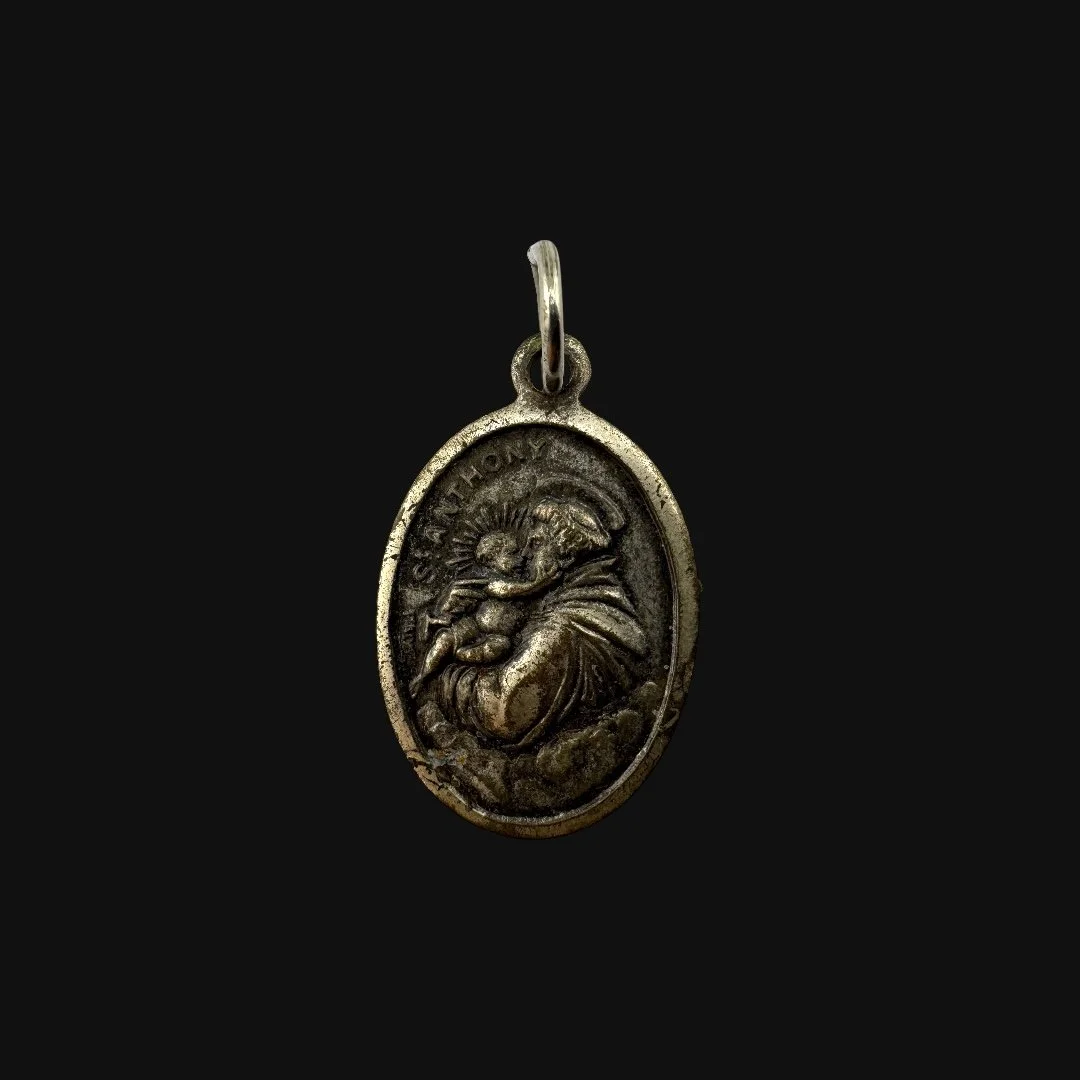 Image 1 of 10
Image 1 of 10

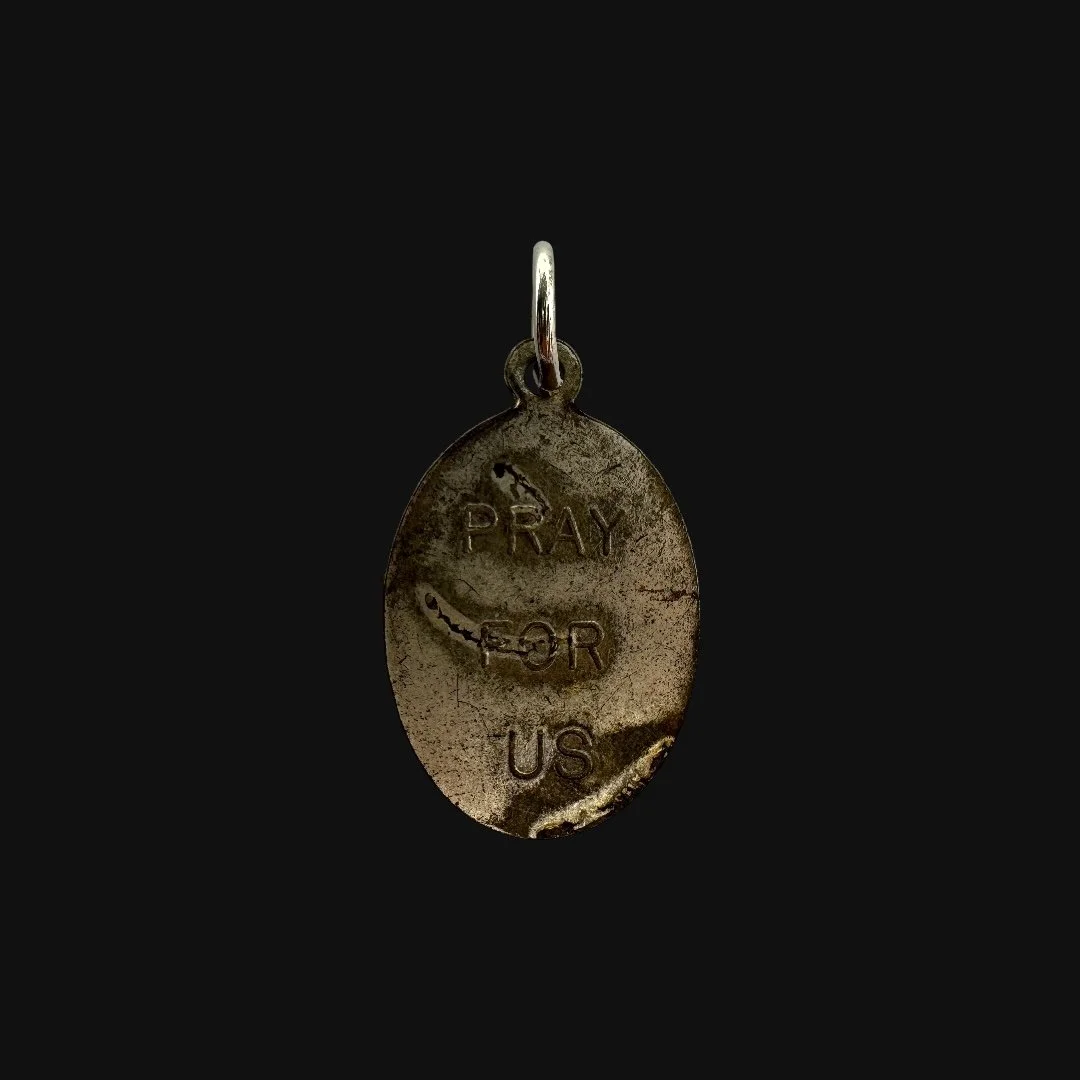 Image 2 of 10
Image 2 of 10

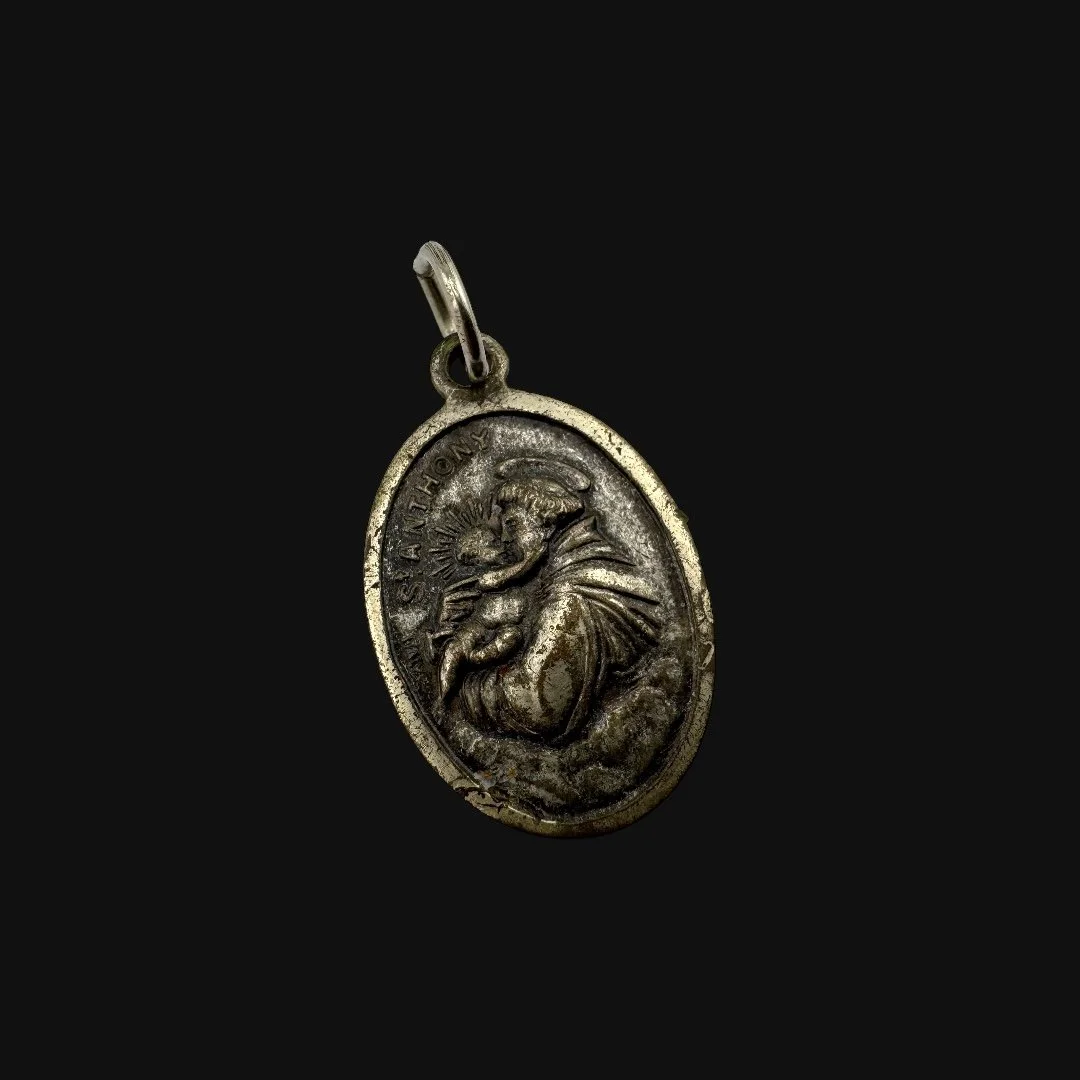 Image 3 of 10
Image 3 of 10

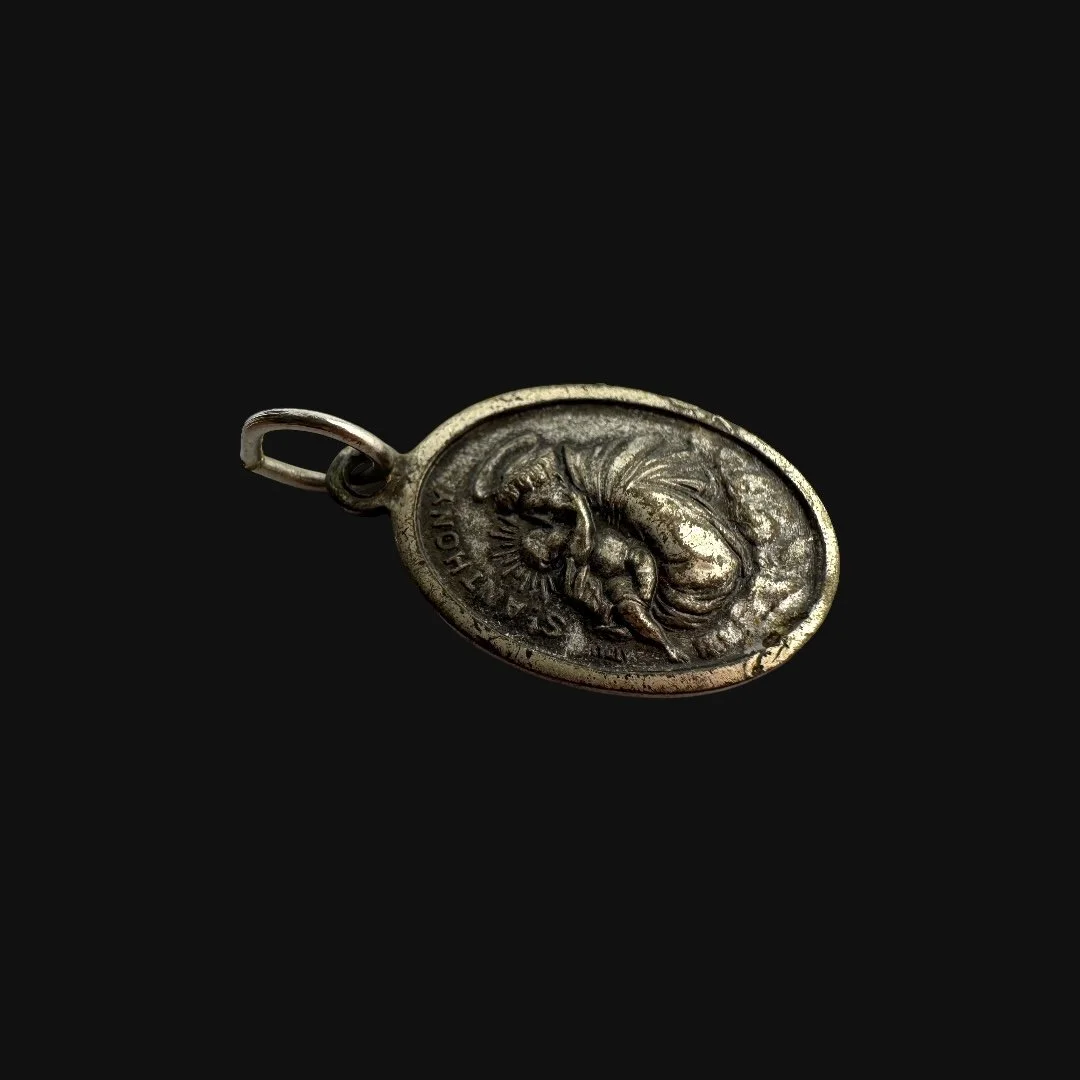 Image 4 of 10
Image 4 of 10

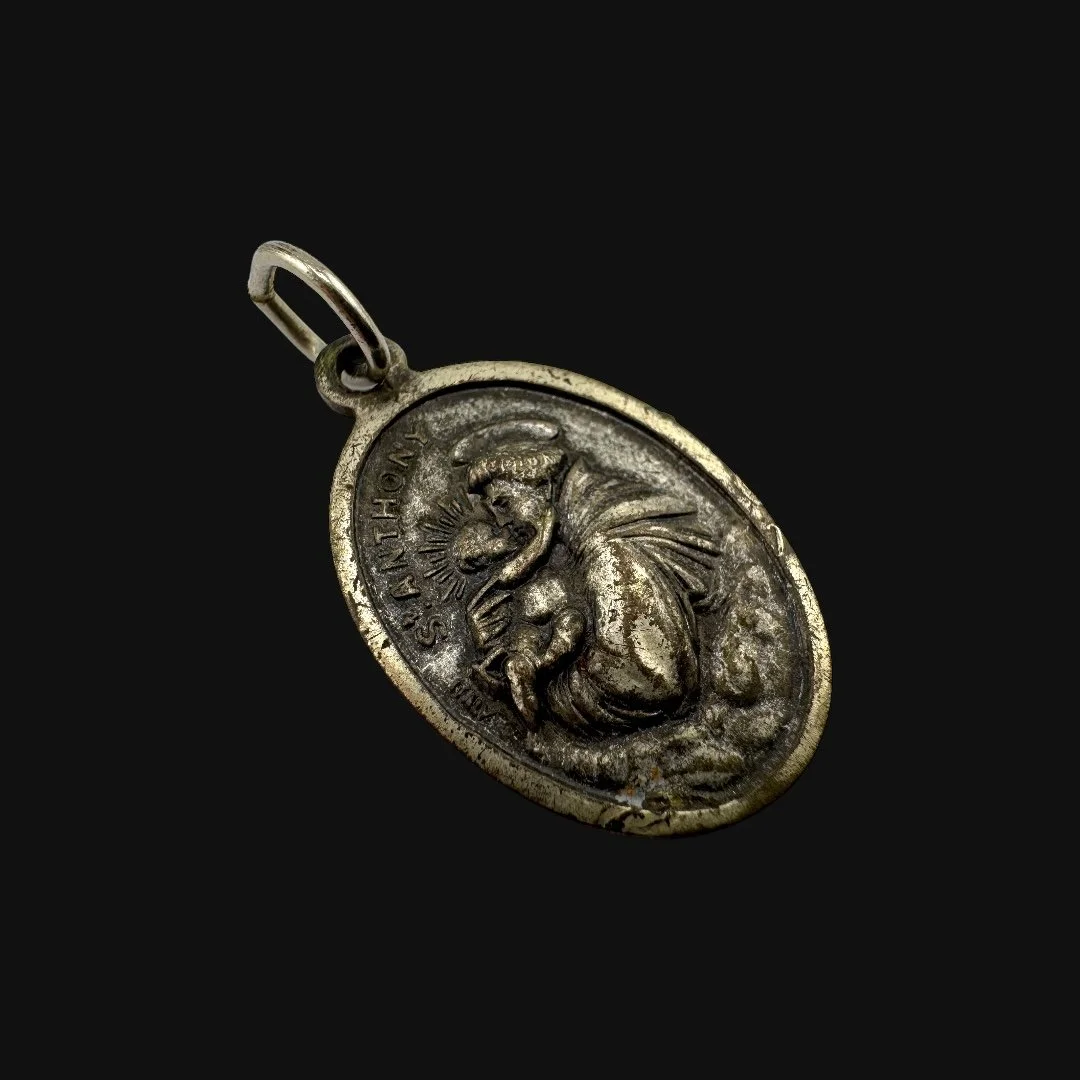 Image 5 of 10
Image 5 of 10

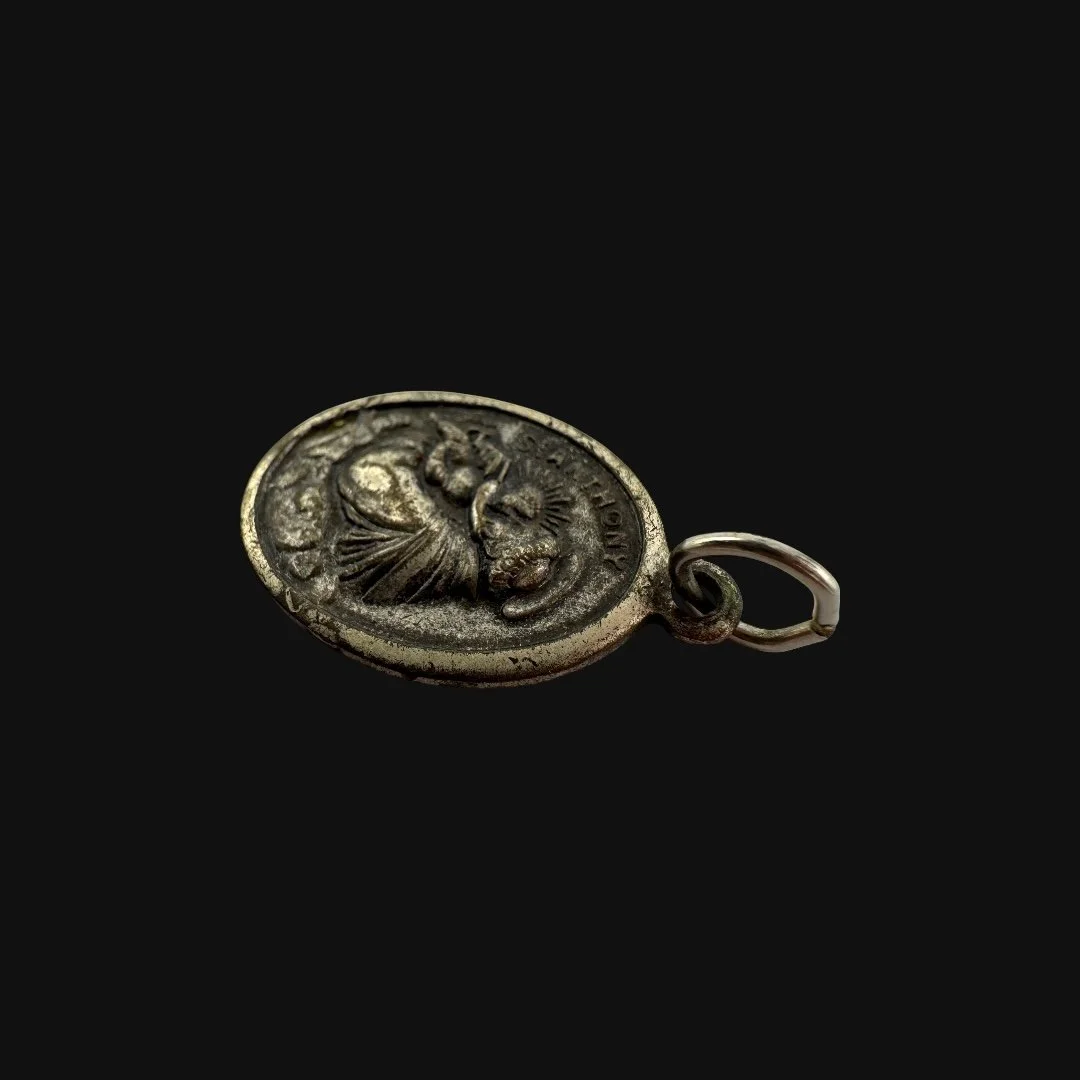 Image 6 of 10
Image 6 of 10

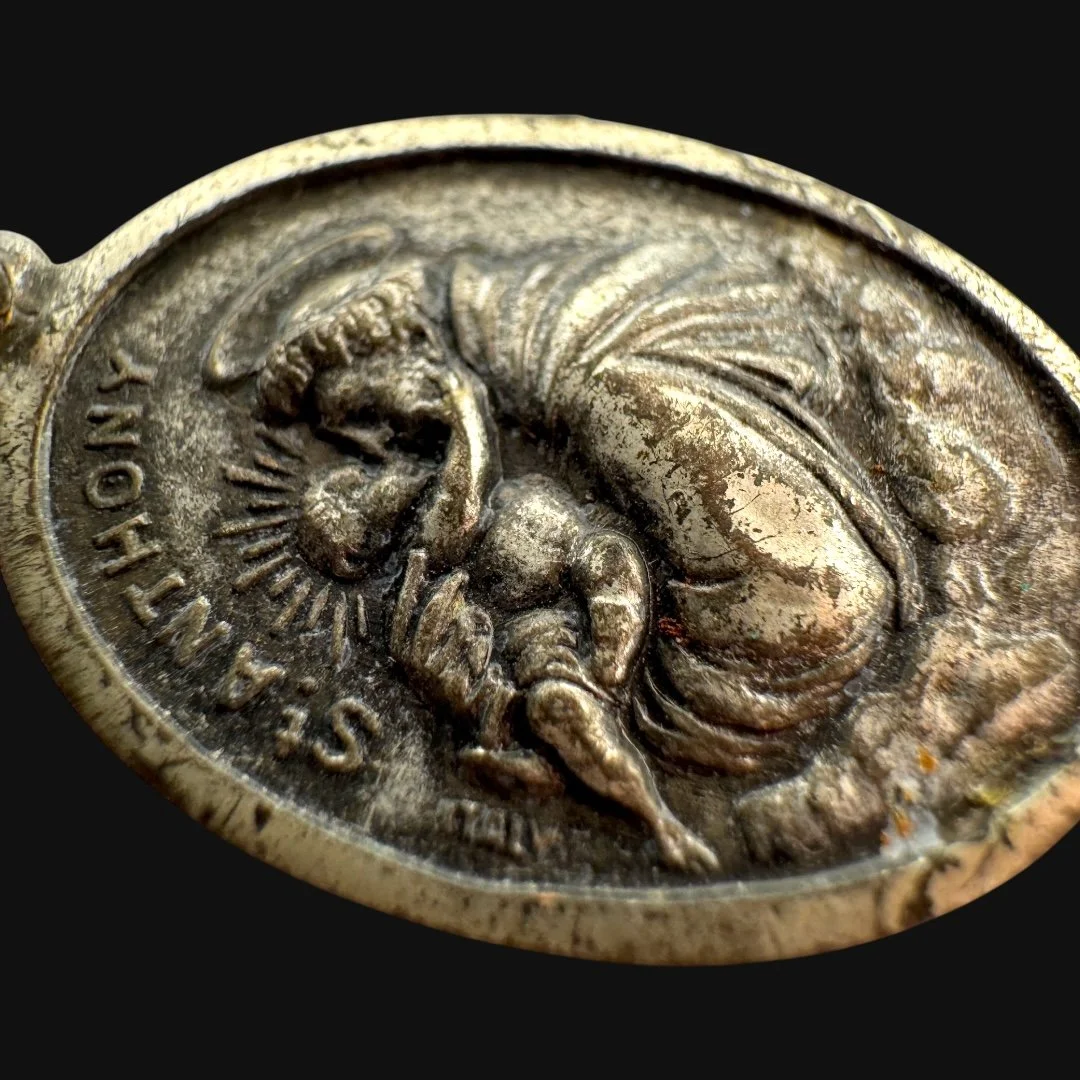 Image 7 of 10
Image 7 of 10

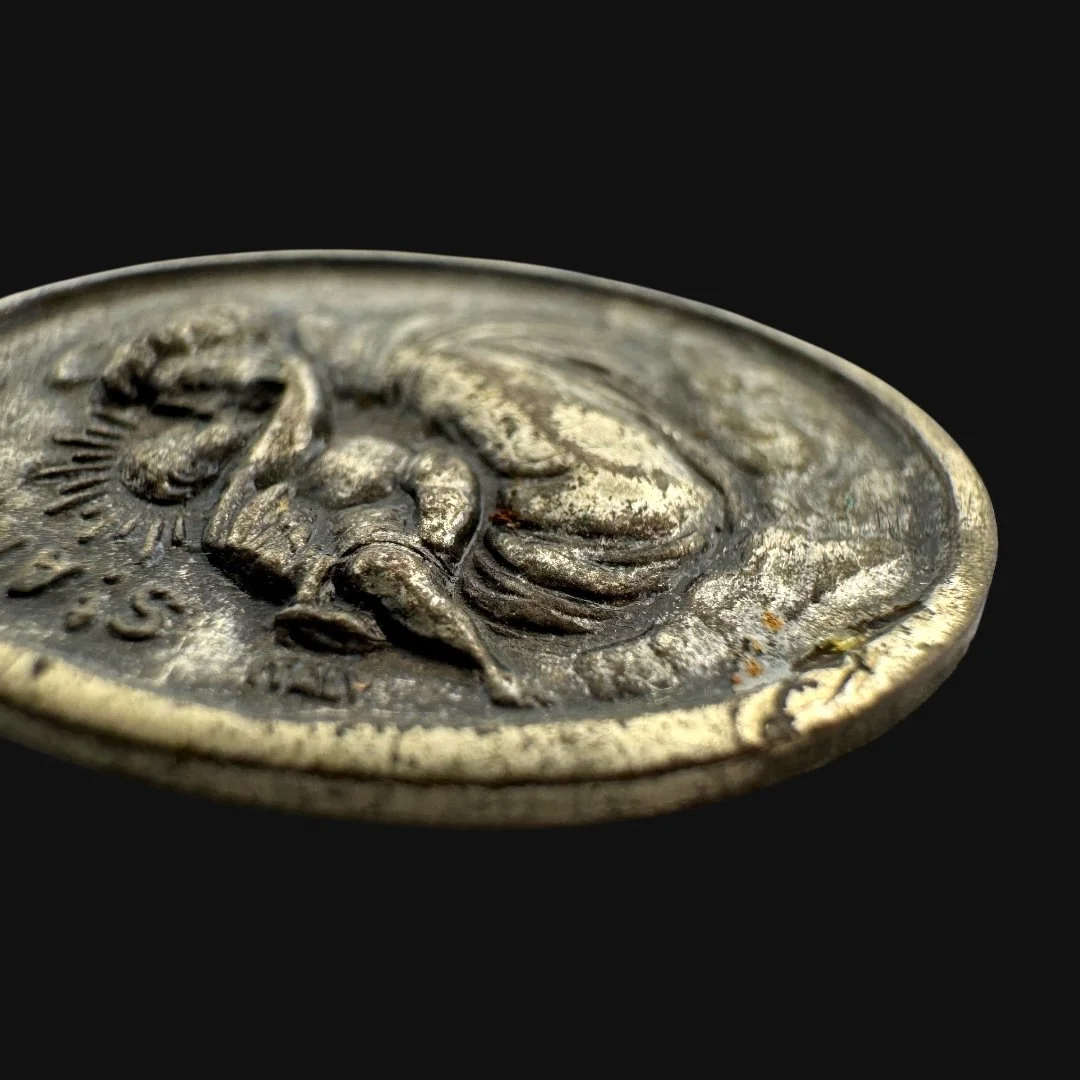 Image 8 of 10
Image 8 of 10

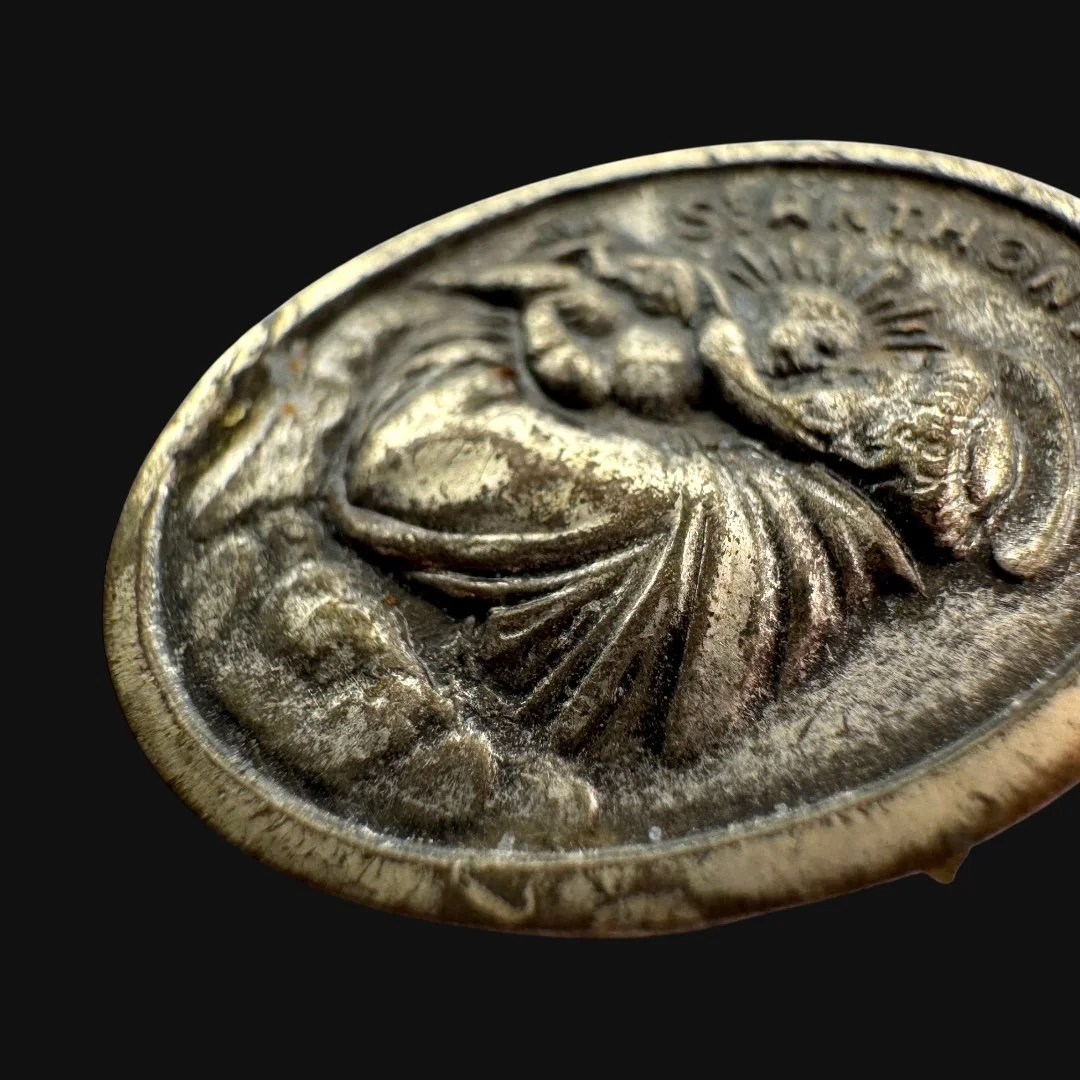 Image 9 of 10
Image 9 of 10

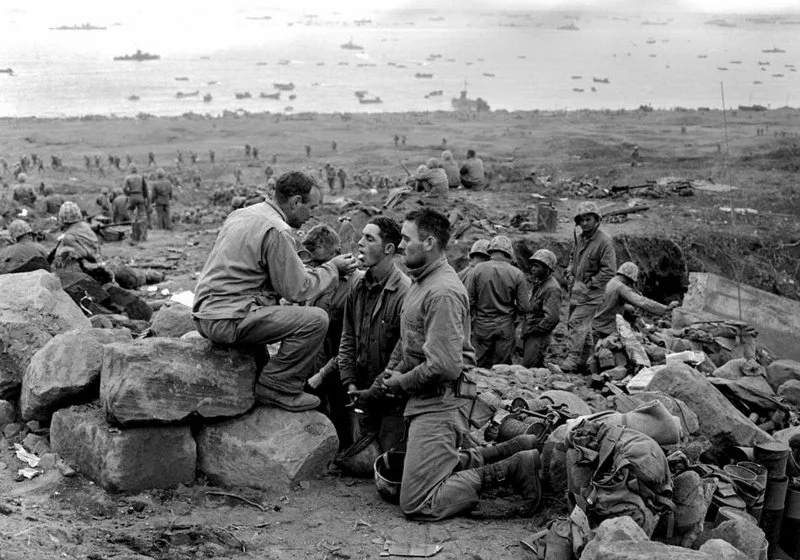 Image 10 of 10
Image 10 of 10











Original WWII 1941-1945 U.S. Soldier's “St. Anthony - PRAY FOR US” Theater-Worn Military Religious Necklace Pendant
Comes with a hand-signed C.O.A. and a full historical research write-up
From: World War II
Dated: 1941-1945
Pendant Size: Small/Medium (25.5mm x 16mm)
Inscription: “St. Anthony - PRAY FOR US”
Wearable History Collection:
This authentic 1941-1945 WWII-era soldier’s necklace pendant, preserved in its original and unaltered condition, combines exceptional craftsmanship with lasting durability, making it fully suitable for modern wear today. As part of our exclusive World War II “Wearable History Pendant Collection,” it offers the rare opportunity to own and wear a genuine piece of World War II. Both a timeless accessory and a tangible link to the past, this truly one-of-a-kind necklace pendant stands as a wearable tribute to the courage and sacrifice of a generation.
During World War II, soldiers carried more than rifles, rations, and uniforms into the field. Many brought tokens of faith, love, or luck to help them endure the hardships of war. Among these treasured keepsakes was the Saint Anthony pendant. Small, modest, and deeply meaningful, these medals bore the image of Saint Anthony of Padua, the patron saint of lost things and lost people. For soldiers heading into unfamiliar terrain and dangerous campaigns, he symbolized guidance, protection, and the hope of safe return.
Like other religious medals of the era, Saint Anthony pendants were not officially issued by the U.S. Army, Navy, or Marine Corps. Instead, they were purchased privately through churches, Catholic supply shops, jewelry stores, or occasionally PX (Post Exchange) shops. Families frequently gave them as gifts before their sons, husbands, and brothers left home. Wives and sweethearts mailed them overseas, tucking them into care packages with letters and photographs. Soldiers themselves sometimes bought them for reassurance before embarking on missions.
By the 1940s, millions of devotional medals were being produced in the United States and abroad. Saint Anthony medals came in sterling silver, brass, nickel, or lightweight aluminum. They were compact and discreet, making them easy to wear alongside dog tags or keep tucked into a pocket.
Although Saint Anthony is especially revered in Catholic tradition, his role as protector of the lost resonated broadly. Catholic soldiers wore the pendants as signs of devotion, while others carried them as symbols of luck and hope. In the confusion of battle, where men were separated from their units, lost in forests, or feared they might never return home, Saint Anthony became a powerful figure of comfort.
The pendant carried more than spiritual symbolism. It served as a personal connection to home. Mothers placed them in their sons’ hands with whispered prayers. Sweethearts clasped them around their fiancés’ necks before final goodbyes. Each pendant carried with it not only religious meaning but also the love and hopes of the person who had given it.
Accounts from the Front
In soldiers’ letters and diaries, Saint Anthony pendants occasionally appear. A paratrooper preparing for Normandy wrote that he carried his “St. Anthony medal beside the tags so I won’t be lost from my brothers.” Sailors in the Pacific often wore them under their uniforms, hoping for safe passage through the vast and dangerous ocean. Pilots, facing some of the highest mortality rates of the war, often carried religious medals in their flight suits, and Saint Anthony was a natural protector against becoming “lost” over enemy skies.
Examples in Wartime Use
European Theater: Some infantrymen carried Saint Anthony pendants during the Normandy invasion and across France, seeing him as a guide through hedgerows, forests, and occupied towns.
Pacific Theater: Marines and sailors invoked his protection during chaotic island-hopping campaigns, from Guadalcanal to Okinawa. His role as guardian of the lost was especially meaningful in the disorienting jungles of the Pacific.
Air Force Missions: Bomber crews carried pendants on missions over Germany, seeking Saint Anthony’s intercession not to be “lost” in the air or over enemy territory.
The Legacy Within This WWII Necklace Pendant:
This original World War II soldier’s necklace pendant was worn as a symbol of faith as they faced the most dangerous campaigns of the war. From the beaches of Normandy and the frozen Ardennes to the islands of Guadalcanal and Iwo Jima, pendants like these traveled with their wearers through the fire of battle. They carried silent strength in the foxholes, aboard the landing craft, and in the skies above Europe and the Pacific. For many young men, they were reminders of family, faith, and home. Every scratch and worn edge tells a story. It reflects long marches under heavy packs, nights spent under artillery fire, and the constant weight of uncertainty. These pendants were deeply personal talismans, often gifted by loved ones, worn close to the heart through the trials of war. To own and wear an original World War II pendant today is to hold a tangible piece of that history. Each is one of a kind. No two carry the same marks, memories, or path through the war. Wearing this meaningful and historical WWII pendant is a natural conversation starter. A way to honor the service of family members who fought in the conflict and to continue carrying the legacy of the Greatest Generation forward. This pendant is not only jewelry. It is a living connection to the past. A reminder of courage, sacrifice, and the enduring spirit of those who shaped history in World War II.
Comes with a hand-signed C.O.A. and a full historical research write-up
From: World War II
Dated: 1941-1945
Pendant Size: Small/Medium (25.5mm x 16mm)
Inscription: “St. Anthony - PRAY FOR US”
Wearable History Collection:
This authentic 1941-1945 WWII-era soldier’s necklace pendant, preserved in its original and unaltered condition, combines exceptional craftsmanship with lasting durability, making it fully suitable for modern wear today. As part of our exclusive World War II “Wearable History Pendant Collection,” it offers the rare opportunity to own and wear a genuine piece of World War II. Both a timeless accessory and a tangible link to the past, this truly one-of-a-kind necklace pendant stands as a wearable tribute to the courage and sacrifice of a generation.
During World War II, soldiers carried more than rifles, rations, and uniforms into the field. Many brought tokens of faith, love, or luck to help them endure the hardships of war. Among these treasured keepsakes was the Saint Anthony pendant. Small, modest, and deeply meaningful, these medals bore the image of Saint Anthony of Padua, the patron saint of lost things and lost people. For soldiers heading into unfamiliar terrain and dangerous campaigns, he symbolized guidance, protection, and the hope of safe return.
Like other religious medals of the era, Saint Anthony pendants were not officially issued by the U.S. Army, Navy, or Marine Corps. Instead, they were purchased privately through churches, Catholic supply shops, jewelry stores, or occasionally PX (Post Exchange) shops. Families frequently gave them as gifts before their sons, husbands, and brothers left home. Wives and sweethearts mailed them overseas, tucking them into care packages with letters and photographs. Soldiers themselves sometimes bought them for reassurance before embarking on missions.
By the 1940s, millions of devotional medals were being produced in the United States and abroad. Saint Anthony medals came in sterling silver, brass, nickel, or lightweight aluminum. They were compact and discreet, making them easy to wear alongside dog tags or keep tucked into a pocket.
Although Saint Anthony is especially revered in Catholic tradition, his role as protector of the lost resonated broadly. Catholic soldiers wore the pendants as signs of devotion, while others carried them as symbols of luck and hope. In the confusion of battle, where men were separated from their units, lost in forests, or feared they might never return home, Saint Anthony became a powerful figure of comfort.
The pendant carried more than spiritual symbolism. It served as a personal connection to home. Mothers placed them in their sons’ hands with whispered prayers. Sweethearts clasped them around their fiancés’ necks before final goodbyes. Each pendant carried with it not only religious meaning but also the love and hopes of the person who had given it.
Accounts from the Front
In soldiers’ letters and diaries, Saint Anthony pendants occasionally appear. A paratrooper preparing for Normandy wrote that he carried his “St. Anthony medal beside the tags so I won’t be lost from my brothers.” Sailors in the Pacific often wore them under their uniforms, hoping for safe passage through the vast and dangerous ocean. Pilots, facing some of the highest mortality rates of the war, often carried religious medals in their flight suits, and Saint Anthony was a natural protector against becoming “lost” over enemy skies.
Examples in Wartime Use
European Theater: Some infantrymen carried Saint Anthony pendants during the Normandy invasion and across France, seeing him as a guide through hedgerows, forests, and occupied towns.
Pacific Theater: Marines and sailors invoked his protection during chaotic island-hopping campaigns, from Guadalcanal to Okinawa. His role as guardian of the lost was especially meaningful in the disorienting jungles of the Pacific.
Air Force Missions: Bomber crews carried pendants on missions over Germany, seeking Saint Anthony’s intercession not to be “lost” in the air or over enemy territory.
The Legacy Within This WWII Necklace Pendant:
This original World War II soldier’s necklace pendant was worn as a symbol of faith as they faced the most dangerous campaigns of the war. From the beaches of Normandy and the frozen Ardennes to the islands of Guadalcanal and Iwo Jima, pendants like these traveled with their wearers through the fire of battle. They carried silent strength in the foxholes, aboard the landing craft, and in the skies above Europe and the Pacific. For many young men, they were reminders of family, faith, and home. Every scratch and worn edge tells a story. It reflects long marches under heavy packs, nights spent under artillery fire, and the constant weight of uncertainty. These pendants were deeply personal talismans, often gifted by loved ones, worn close to the heart through the trials of war. To own and wear an original World War II pendant today is to hold a tangible piece of that history. Each is one of a kind. No two carry the same marks, memories, or path through the war. Wearing this meaningful and historical WWII pendant is a natural conversation starter. A way to honor the service of family members who fought in the conflict and to continue carrying the legacy of the Greatest Generation forward. This pendant is not only jewelry. It is a living connection to the past. A reminder of courage, sacrifice, and the enduring spirit of those who shaped history in World War II.